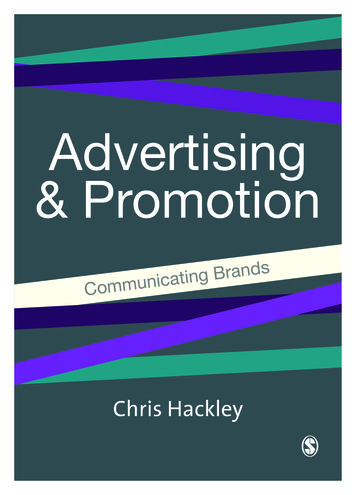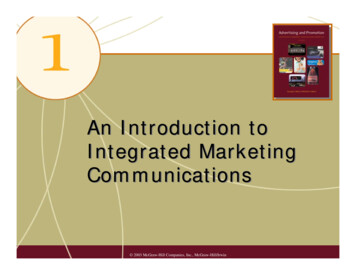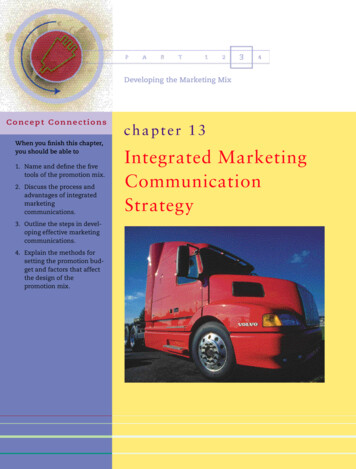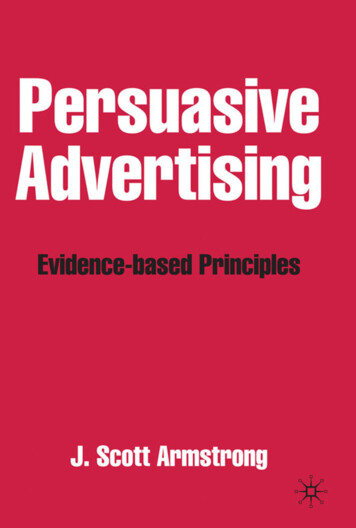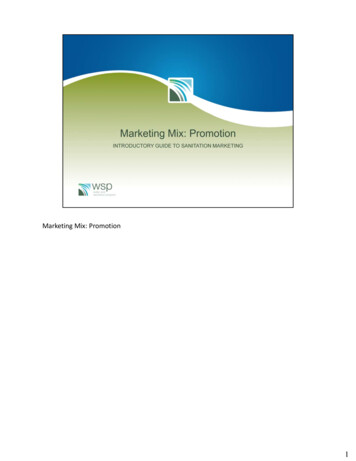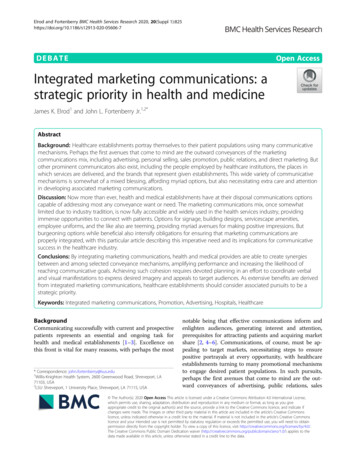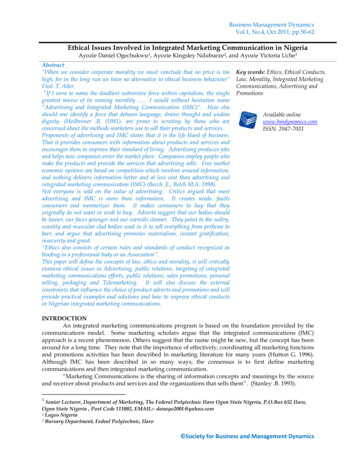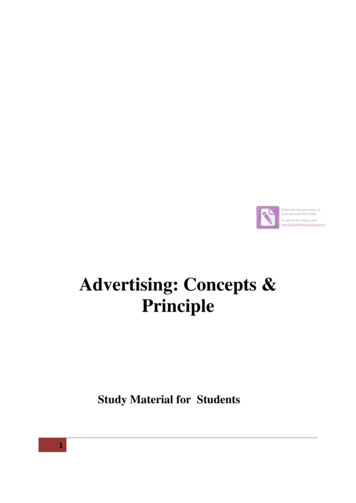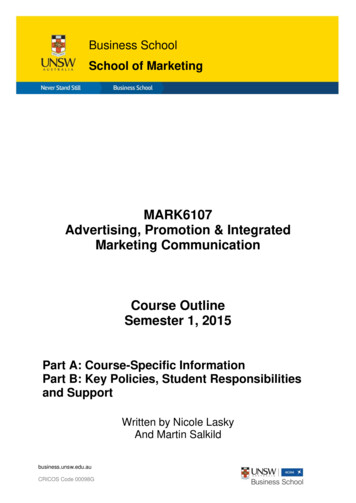
Transcription
Business SchoolSchool of MarketingMARK6107Advertising, Promotion & IntegratedMarketing CommunicationCourse OutlineSemester 1, 2015Part A: Course-Specific InformationPart B: Key Policies, Student Responsibilitiesand SupportWritten by Nicole LaskyAnd Martin Salkildbusiness.unsw.edu.auCRICOS Code 00098G
Table of ContentsPART A: COURSE-SPECIFIC INFORMATION11STAFF CONTACT DETAILS12COURSE DETAILS12.12.22.32.42.5Teaching Times and LocationsUnits of CreditSummary of CourseCourse Aims and Relationship to Other CoursesStudent Learning Outcomes11223LEARNING AND TEACHING ACTIVITIES533.1 Approach to Learning and Teaching in the Course3.2 Learning Activities and Teaching Strategies55464.14.24.34.44.5ASSESSMENTFormal RequirementsAssessment DetailsAssessment FormatAssignment Submission ProcedureLate Submission667Error! Bookmark not defined.125COURSE RESOURCES136COURSE EVALUATION AND DEVELOPMENT157COURSE SCHEDULE16PART B: KEY POLICIES, STUDENT RESPONSIBILITIES AND SUPPORT198PROGRAM LEARNING GOALS AND OUTCOMES199ACADEMIC HONESTY AND PLAGIARISM2010STUDENT RESPONSIBILITIES AND eral Conduct and BehaviourOccupational Health and SafetyKeeping Informed202020212111SPECIAL CONSIDERATION2112STUDENT RESOURCES AND SUPPORT21business.unsw.edu.auCRICOS Code 00098G
PART A: COURSE-SPECIFIC INFORMATION1 STAFF CONTACT DETAILSLecturer in Charge and Lecturer Module A: Nicole LaskyNicole Lasky has a strong background in both university teaching and industry. Shehas taught a variety of marketing subjects since 1996, combining both theory andpractice to provide students with the skills they need to succeed in a competitive globalmarketplace. Nicole also has experience in property development, doing large scaleprojects for Mirvac and AMP, where she was responsible for the strategic planning andimplementation of design, financial planning, construction and marketing of businesscampuses and shopping centres. Marketing of properties included developingmarketing strategy, creating integrated marketing communication plans andimplementing the plans. Nicole is also a final year UNSW PhD in Marketing Candidate.Co-Lecturer, Module B: Martin SalkildMartin Salkild has spent his whole career in advertising apart from a brief spell as amilitary radar designer and a trainee brand manager. After that it was into planning atthe Publicis agency in London and then on to several leading Australian agencies asaccount director. He was also a founding member of a small agency running the LandRover account for seven years. Martin now consults to the alcohol industry reviewingadvertising campaigns to ensure compliance with the alcohol code. All those years inadvertising are still being put to good use with Martin able to entice a stellar group ofguest lecturers to share their knowledge with students on his lOfficeNicole Laskyn.lasky@unsw.edu.auQuadrangleBuilding 3rdFloor, Room3044Martin SalkildQuadrangleBuilding 3rdmartin@salkild.com.auFloor, Room3041Phone9385 36150414 254448Consultation will be by appointment.2 COURSE DETAILS2.1Teaching Times and LocationsSeminars start in Week 1, 3 March (to Week 12): The Time and Location are:Tuesdays, 6:00pm to 9:00pm.2.2Units of CreditThe course is worth 6 units of credit.business.unsw.edu.auCRICOS Code 00098G1
2.3Summary of CourseThis course aims to give students a better understanding of contemporarycommunications thinking and integrated marketing communications (IMC), as practicedby marketing managers. It gives participants practical skills in developing andmanaging advertising and sales promotions programs, media planning, and clientagency relations. The client and the agency should both be working to the same goal ofachieving business objectives through a well-planned and well-executed marketingcommunications campaign. IMC is a methodology and a way of thinking aboutcommunication which was created to manage brands in the new brand communicationlandscape. The essence of IMC is that everything a company does, and sometimeswhat it doesn’t do, can send a powerful brand message. IMC looks at the differentways for companies to communicate about their brand, in an integrated fashion, whichtakes advantage of the differences between media and leverages their strengths. Thiscourse will profile a number of frameworks and theories to elaborate and evaluatecommunication initiatives.This course will be divided into Modules 1 & 2.In Module 1, you will learn that IMC is a methodology and a way of thinking aboutcommunication which was created to manage brands in the new brand communicationlandscape. The essence of IMC is that everything a company does, and sometimeswhat it doesn’t do, can send a powerful brand message. Much of IMC is still aboutadvertising but it just goes much deeper and is much wider in scope. While learninghow to develop an IMC strategy, you will be introduced to a number of frameworks andtools to increase your chances of success.In Module 2 you will learn about the advertising industry, evaluate specific media andlearn to create a contemporary creative brief and to “pitch it.” This is a practical basedcourse where you will step into the shoes of an advertising professional for six weeksand learn what it is like to be on the supplier side of the marketing/advertising divide.You will learn to differentiate between a good ad and a bad ad. You will discover howto write a creative brief to direct and inspire a creative team. And you will experiencewhat it is like to prepare an integrated advertising campaign for a problem brand forwhich you have received an inadequate advertising brief. Welcome to the real world.Course Aims and Relationship to Other CoursesThe aim of this course if for you to: Learn how to gauge consumer insightsLearn how to develop an IMC strategyLearn how to use strategy to develop your campaignLearn how to develop a promotional campaignLearn some of the latest promotional techniques and be able to evaluate andselect based on your situationThis course is part of the Master of Marketing program and builds upon the conceptsyou have learned from MARK6100 Marketing Management: Contemporary AnalyticalPerspectives.business.unsw.edu.auCRICOS Code 00098G2
2.4Student Learning OutcomesThe Course Learning Outcomes are what you should be able to DO by the end of thiscourse if you participate fully in learning activities and successfully complete theassessment items.The Learning Outcomes in this course also help you to achieve some of the overallProgram Learning Goals and Outcomes for all postgraduate coursework students inthe Business School. Program Learning Goals are what we want you to BE or HAVEby the time you successfully complete your degree (e.g. ‘be an effective team player’).You demonstrate this by achieving specific Program Learning Outcomes - what youare able to DO by the end of your degree (e.g. ‘participate collaboratively andresponsibly in teams’).For more information on the Postgraduate Coursework Program Learning Goals andOutcomes, see Part B of the course outline.By the end of this course, you should be able to:1. Evaluate the effectiveness of an integrated communication campaign2. Evaluate the trade-offs between traditional and non-traditional marketingcampaigns3. Design positioning statements4. Write and evaluate creative briefs5. Be able to communicate and sell your arguments and creative ideas6. Work collaboratively to complete a taskBusiness Postgraduate Coursework Program Learning Goals and Outcomes1. Knowledge: Our graduates will have current disciplinary or interdisciplinary knowledgeapplicable in local and global contexts.You should be able to identify and apply current knowledge of disciplinary or interdisciplinary theory andprofessional practice to business in local and global environments.2. Critical thinking and problem solving: Our graduates will have critical thinking and problemsolving skills applicable to business and management practice or issues.You should be able to identify, research and analyse complex issues and problems in business and/ormanagement, and propose appropriate and well-justified solutions.3. Communication: Our graduates will be effective communicators in professional contexts.You should be able to:a. Produce written documents that communicate complex disciplinary ideas andinformation effectively for the intended audience and purpose, andb. Produce oral presentations that communicate complex disciplinary ideas and informationeffectively for the intended audience and purpose.4. Teamwork: Our graduates will be effective team participants.You should be able to participate collaboratively and responsibly in teams, and reflect on your ownteamwork, and on the team’s processes and ability to achieve outcomes.5. Ethical, social and environmental responsibility: Our graduates will have a sound awareness ofethical, social, cultural and environmental implications of business issues and practice.You should be able to:a. Identify and assess ethical, environmental and/or sustainability considerations in businessdecision-making and practice, andb. Consider social and cultural implications of business and /or management practice.business.unsw.edu.auCRICOS Code 00098G3
The following table shows how your Course Learning Outcomes relate to the overallProgram Learning Goals and Outcomes, and indicates where these are assessed (theymay also be developed in tutorials and other activities):Program LearningGoals and OutcomesCourse Learning OutcomesCourse AssessmentItemThis course helps you toachieve the followinglearning goals for allpostgraduatecoursework students:On successful completion of the course, youshould be able to:This learning outcomewill be assessed in thefollowing items:1KnowledgeUnderstand the concept of IMCUnderstand how brand equity relates to IMCUnderstand IMC frameworksUnderstand what communicationsprofessionals can provide to you as amarketing specialist.Understand how to create an environmentfor communications professionals to give youthe best outcomes and how to manage theclient/agency relationship.Have a better appreciation of the creativeprocess, strategy development,contemporary integrated marketing, the roleof PR.Appreciate the emerging importance ofbehavioural economics in research.2Critical thinkingand problemsolvingIMC Part AIMC Part BIMC Part BIMC Part CIMC Part CIMC Part DIMC Part DDiscover consumer insightsIMC Part AAnalyse the competitive environmentIMC Part ADesign positioning statementsIMC Part BLearn how to write a creative brief that candirect and inspire a creative team.Critique ads and writea creative brief.IMC Part CIMC Part D3aWrittencommunicationbusiness.unsw.edu.auCRICOS Code 00098GConstruct written work which is logically andprofessionally presented.IMC Part AIMC Part BIMC Part D4
3bOralcommunicationCommunicate ideas in a succinct and clearmanner.IMC Part C4TeamworkWork collaboratively to complete a task.IMC Part BIMC Part C5a.Ethical,environmental andsustainabilityresponsibilityWe will discuss ethics and regulation inadvertising and the advertiser’s responsibilityfor truth well told.Not specificallyassessed. Howeverwill be discussed inclass as a componentof the class lectures.5b.Social and culturalawarenessBe able to critique advertising in aprofessional manner from the perspective ofboth the creator and receiver of theadvertising message.Critique ads and writea creative brief.3 LEARNING AND TEACHING ACTIVITIES3.1Approach to Learning and Teaching in the CourseThe approach of this course is to combine conceptual information with real worldpractice. Concepts and frameworks are important to learn as only by understandingframeworks can practitioners adapt to changes in the environment. These frameworkswill be learned from lectures and the readings. As this is a professional postgraduatecourse, lectures will be short, covering only main concepts of the readings. It isexpected that you have prepared by reading in advance. However, you must alsounderstand how to apply concepts and frameworks in real situations, hence thepractical component of learning. Examples of how to apply will be drawn from realexperience from instructors and students. By examining real situations and firms, youwill practice making real decisions.In Module 2 learning and teaching and will be achieved with the help of guest lecturesfrom leading communications companies from a variety of areas of the communicationsmix. For students, regardless of your individual background, whether from marketing,sales, advertising, media or whatever, over the six week course you will “thinkyourselves” onto the advertising agency side of the business as if you are being trainedto enter the advertising industry. You will assume responsibility for understandingadvertising and for appreciating how to critique, brief and assess advertising. You willlearn how to work in an agency team to create an effective advertising and promotionprogram for a brand with a problem.3.2Learning Activities and Teaching StrategiesClasses will be run as seminars with short lectures that will outline the main conceptsof integrated marketing communication, real-world examples and their managerialimplications. They will be interactive with students free to ask questions at any timeand participate in class exercises. The relevant readings, to be read in your own time,provide more detail about these concepts. To illustrate the concepts with practicalexamples, lectures will draw on the experiences of instructors, students andoccasionally industry practitioners.Discussions will follow the lecture part of the class and be used to:business.unsw.edu.auCRICOS Code 00098G5
reinforce concepts apply the concepts from readings to practical examples enhance critical thinking and analysis skills enhance writing and oral presentation skills; and networkUse of computers in classFeel free to use of computers for note taking, but not for surfing. Texting on mobilephones is also unacceptable. Those activities are professionally discourteous to theguests who have given their time to talk with us and are distracting to other students.Copies of the lecturers’ notes will be posted on Moodle so you will only need to writedown anything you really want to remember. It’s far better to listen to what’s being saidthan to frantically try to record every word.4 ASSESSMENT4.1Formal RequirementsIn order to pass this course, you must: achieve a composite mark of at least 50; and attend 80% of the classes; and make a satisfactory attempt at all assessment tasks (see below).4.2Assessment DetailsAssessment TaskWeightingLengthDue Date1. IMC Part A:IndividualConsumer Insightsand CompetitiveAnalysis ResearchReport25%1000 – 1200wordsWeek 4: Monday, 23 MarchSubmit online to Moodle6:00pm2. IMC Part B:GroupIMC StrategyReport15%1200 – 1500words(about 1000words from part AWeek 6: Wednesday, 15April 6:00pmSubmit online to Moodle3-4 pagesWeek 9: Monday 4 May6:00pmModule 1Module 23. Critique adsIndividualPrepare a CreativeBrief25%4. IMC Part C:GroupClass Presentation15%5. IMC Part D:Individual FinalWritten Reportbusiness.unsw.edu.auCRICOS Code 00098Gplus cover pageSubmit online to Moodle20%Approx 15minutesWeek 12: Tuesday, 26May 6:00pmApprox 15 to 20pagesBy: Thursday, 11 June6:00pmSubmit online to Moodle6
Several of your assignments will be linked together this semester, enabling you todevelop a progressive (accumulative) piece of work. You will be given feedback andadvice along the way, which will help you to learn, improve and increase the likelihoodof achieving a strong final piece of work. You will also gain solid integrated marketingcommunication skills.In Week 1 you will form groups and select what you consider is a brand with anineffective advertising campaign which could be improved with a better strategy andbetter creative and media.You will then individually research and write about the brand’s consumers andcompetitors, resulting in an analytic report due in Week 4 (IMC Part A).You will then re-join your groups to work on IMC Part B, which will includecontributions from your research from Assignment 1 (about 1000 words), creating andadding a new IMC strategy (additional 500 words).In Module 2, you will then develop IMC Part C: Group Presentation after receivingfeedback from Assignment 2, which will be a creative pitch based on your IMCstrategy.You will again receive feedback from the presentation, giving you two weeks to writethe final creative pitch (IMC Part D) individually. You will already have about 5-6pages from assignment 2 to start you off and all of the shared materials from the grouppresentation. However, you will develop the document and submit individually. Basedon the group presentation feedback, you are free to change anything from thepresentation.Critique ads/prepare a creative brief is individual and separate from the main project,but will assist you in improving your skills for the main project.Module 1IMC Part A: Individual Consumer Insights and Competitive AnalysisResearch ReportWorth 25% of CourseStudents will form groups in Week 1 and will select what you consider is a brand withan ineffective advertising campaign which could be improved with a better strategy andbetter creative and media. Students should choose a brand that is not too broad ormulti-faceted. This will be discussed in Week 1 in more detail.Then individually, students will research and write IMC Part A.Before developing any strategy or creative work, it is important to research your targetmarket competitors, and industry. An integrated marketing communications campaignis a combination of creativity and insights learned from research. In IMC Part A youwill delve into the target market of your brand. Consider the following: How is the market segmented? What is the consumer buying behaviour? How do consumers currently perceive the brand?business.unsw.edu.auCRICOS Code 00098G7
What needs (functional and emotional) do consumers have? Are they latentneeds? How do consumers perceive the major competitors? What gaps exist, ie unfulfilled needs? Can market driving be applied? Conclude, by explaining what you have discovered about consumer insights andany expressed or latent needs.Avoid/copy paste, paraphrasing all work. Your assignments will be submitted to aprogram called Turn-It-In which will provide a similarity index to other assignments andweb pages. You should aim for a similarity index of less than 10%.Ensure that you reference all of your work both in-text and on the references pageusing correct Harvard, APA or Journal of Marketing style.IMC Part B: Group IMC Strategy ReportWorth 15% of CourseFor this assignment, work with your group, merging your findings from IMC Part A.The aim is to use what you have learned to develop and IMC strategy.You will: Create a perceptual map using two logic factors, plotting competitors and thebrand under investigation (You may plot their current position and recommendedposition). Develop a positioning statement based on the perceptual map. Write your draft “big idea”, based on your positioning statement, including brandessence, brand personality and slogan Write your draft appeal, explaining what type of specific rational or emotionalappeal you have chosen.Module 2Critique ads Individual – prepare a creative briefWorth 25% of total course markEveryone involved in marketing communications needs to be able to form and expressopinions about advertising and advertisements. Whether we are looking at ads thathave been produced in response to a creative brief, or if we just see an ad on TV, theweb, or in a magazine, we need to be able to give a more reasoned response than “It’sno good” or “It’s great” or “I don’t like it”.We have to understand and explain why we feel that way. We need a set of criteria tohelp support or qualify our initial reactions.Week 7 will include a discussion on “good” and “bad” advertising. We will review somebusiness.unsw.edu.auCRICOS Code 00098G8
simple techniques for assessing advertising. Based on learnings in weeks 7 and 8, youwill be asked to select, in your opinion, the most effective and the least effective ad in amagazine nominated by your lecturer and to prepare written critiques of each.For the least effective ad, you will also prepare a creative brief that could direct andinspire a creative team to produce a significantly improved advertisement. Yourcreative brief will be based on a format you will be given in week 7. You will submityour assignment in week 9 on Monday, 4 May via Moodle.Format Please think about the quality of your document’s presentation format as if youwere preparing a submission to your management or to a client. Ensure your name, the date, the course name and the assignment topic are clearlyidentified on the front cover using the University’s Assignment Cover Sheet. Type in one and a half spacing in an easy-to-read font such as 11pt Arial like thisdocument. Use appropriate headings and paragraphs so it’s a pleasure to read. Keep your document clear and to the point without unnecessary padding.IMC Part C: Group Class PresentationWorth 15% of course markIn week 7 you will re-join your teams and collaborate as if you were all working for anadvertising agency. Your group will select what you consider is a brand with anineffective advertising campaign which could be improved with a better strategy andbetter creative and media. You will identify its weaknesses and opportunities forimprovement using the knowledge you've gained on research, strategy, creative andmedia.Your task will be to make a class presentation as if you were in a competitive pitch towin a piece of new business. It will be your decision who in the group takes on whichtasks or roles and who prepares which sections of your recommendation andpresentation, but you will definitely need to work as a team.So you will have four weeks from week 8 to week 12 finalise your strategy, developyour creative and media recommendations and prepare your presentation.This will be the living and breathing presentation of your recommendations to a panelof judges. This will be the first time the judges (think of them as your potential client) willhave heard any of your thinking or seen your recommendations.Remember that the judges are watching your presentation in the hope of seeingsomething they can approve. They are on your side.You can use whatever presentation aids you like: PowerPoint, Prezi, whiteboard, flipcharts, layouts, audio, video, handouts, etc, etc. But remember, it’s you who aremaking the presentation, not your presentation aids.By week 11 you will have an overload of information and ideas. You will have tochoose what parts of this information to use and what parts to leave out so you canpresent a clear and compelling case for your recommendations in week 12.business.unsw.edu.auCRICOS Code 00098G9
All members of the agency team must participate in the presentation, but do not needexact equal billing in terms of minutes speaking. However, whatever each membercontributes must be relevant and integrated into the whole presentation.The maximum presentation timing is 15 minutes with a couple of minutes for questions.The assessment of your presentation will be based on: Good understanding of the brand, the market and the consumer Well structured content and presentation Ability to communicate a key message Persuasive and convincing recommendations Seamless transfers between presenters Engaging style; could hold audience attention Effective use of presentation aids or techniques “Wow” factor that sets your presentation apart from the othersIMC Part D: Individual Final Written ReportWorth 20% of course markYour document will be written individually and must be capable of making your case ina stand-alone scenario as if the potential client to whom you had presented yourrecommendations had passed the document on to a senior colleague for review. It willbe up to you how large or involved your document becomes. Make the document aspersuasive as it needs to be to get your points across and your recommendationsaccepted. You will each be able to share the materials from the group presentation, butthen must develop and submit the written document individually.Make sure your document will hold the attention of the reader. Don’t let it becomeboring. Keep it interesting. Make sure the reader can understand where you areheading and follow the logic of your recommendations to the point where they say“Yes, that makes sense, let’s do it.”There will be an opportunity between weeks 10 and 11 to meet with your lecturer todiscuss your project and make sure you are on track.The assessment of your written document will be based on: Overall clarity of thinking Ability to identify campaign weaknesses Ability to recognise opportunities for improvement Quality of background inquiry into the product, consumer and market Strategic insights leading to the creative and media strategy Originality, freshness and creativity of your recommendations Integration of the various components of your recommendations Long term campaignability of your recommendationsbusiness.unsw.edu.auCRICOS Code 00098G10
Realistic budget in relation to the size of the product or the market Presentation of the report: accuracy, design, attention to detail, “reader-friendly”Note about group work and individual weighting of the group markWorking in groups is always challenging, but this is how advertising campaigns arecreated in real life. In group work, students also learn a great deal from fellow groupmembers as the project progresses.Past experience has shown that effective groups are those that are able to: meet regularly; develop and follow a work plan and timetable; divide the work as evenly as possible according to each member’s strengths; encourage open communication, participation and the sharing of ideas.It is suggested a diary be kept by one of the group members to minute meeting times,attendance, issues discussed, and delegation of work to members.If teams are having problems with one or more members not meeting groupobligations, they should first try to resolve differences themselves. If this is notsuccessful, set up a meeting with the Lecturer-in-charge as soon as possible. Don’twait until problems escalate, and please don’t raise problems after the presentationwhen it is too late to help you find a solution.Group members may complete a peer evaluation of the contribution of eachgroup member, including themselves. These evaluations may result in the individualmark for each student being weighted up or down from the group mark.It is in your interest to make your group work effectively to ensure it delivers highquality output. Cohesive and harmonious groups will not have members marked down.4.3Assignment Submission ProcedureAssignments are to be submitted via Moodle.All students should be ready to present in Week 12 at 6:00pm.Assignment 3 will be marked and handed back to students in Week 10 on 12 May.The written component of Assignment 5 with feedback on the class presentation andwritten document will be available after the course marks and grades are announcedafter the end of Semester 1. The annotated assignments can be collected during officehours Monday to Thursday from the School of Marketing Office on the 3rd floor of theQuadrangle Building.Assessment FormatMarksheets will be made available on Moodle Week 1 for Module 1 and Week 7 forModule 2.business.unsw.edu.auCRICOS Code 00098G11
Master of Marketing Grade and Mark rangesThe progressive assessment during the session (either by assignments, participationand/or a mid-session examination), grades will be provided to students in a form of aletter grade (not as a mark) as follows.GradeMarkExplanationA75 - 100 A superior to outstanding performanceB60 - 74 A good performanceC50 - 59 An acceptable level of performanceFail0–49Performance below minimum level of competenceCourse results as a final mark are released to students and are made available ONLYvia MyUNSW (not by the lecturer) following a Faculty sub-committee meeting toapprove distribution of marks.4.4Late SubmissionConsistent with the School of Marketing policy, late submission of written assignmentswill attract a penalty of 10% per day or part thereof. Your written assignment will beconsidered late after a 10-minute grace period. It is the group’s responsibility toorganize their time with progressive individual submissions to the group. If a groupmember does not provide their work to the group, it is the group’s responsibility tocomplete the assignment and submit on-time. All students will be ready to presentWeek 12 at 6:00pm or will be considered late – no grace.Quality AssuranceThe Business School is actively monitoring student learning and quality of the studentexperience in all its programs. A random selection of completed assessment tasks maybe used for quality assurance, such as to determine the extent to which programlearning goals are being achieved. The information is required for accreditationpurposes, and aggregated findings will be used to inform changes aimed at improvingthe quality of Business School programs. All material used for such processes will betreated as confidential.business.unsw.edu.auCRICOS Code 00098G12
5 COURSE RESOURCESThe website for this course is on Moodle at:http://moodle.telt.unsw.edu.auRecommended TextbooksModule 1 will mainly use the following textbook.Belch, George E., Belch, Michael A., Kerr, Gayle & Powell, Irene (2014) Advertising:An Integrated Marketing Communications Perspective (3e), McGraw-Hill, Sydney,NSW Australia (ISBN: 978-174307865-5)This is an Australianised edition of a widely read American text book on integratedmarketing communication and is a good read.Other recommended readings are:Hill, CWL, Jones, GR (2010). Strategic management: An integrated approach (9th ed),Cengage,
communications thinking and integrated marketing communications (IMC), as practiced by marketing managers. It gives participants practical skills in developing and managing advertising and sales promotions programs, media planning, and client-agency relations. The client
